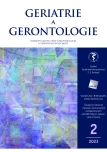Results of surgical treatment of proximal femur fractures in patients operated at the Traumatology Clinic of the University Hospital Olomouc in the years 2017–2021
Authors:
Ošťádal Marek; Vinter Lukáš
Authors‘ workplace:
Traumatologická klinika Lékařské fakulty Univerzity Palackého a Fakultní nemocnice Olomouc
Published in:
Geriatrie a Gerontologie 2023, 12, č. 2: 59-64
Category:
Original Article
Overview
Proximal femur (PF) fracture is one of the most common trauma diagnoses in geriatric patients. The typical patient is a woman 80 years of age after having suffered a low-energy injury, typically a fall after tripping. The most common type of PF fracture in these patients is a pertrochanteric fracture. The patient’s prognosis depends mainly on the medical condition before the accident and age. The aim is to return the patient to the level of mobility before the accident as soon as possible with the least possible reduction in quality of life. The incidence, treatment costs and demands for aftercare capacity will increase.
Keywords:
zlomenina – proximální femur – komplikace – mortalita – ekonomický aspekt
Sources
1. Bartoníček J, Džupa V, Frič V, et al. Epidemiology and economic implications of fractures of proximal femur, proximal humerus, distal radius and fracture-dislocation of ankle. Rozhl Chir 2008; 87(4): 213–219.
2. Douša P, Čech O, Weissinger M, et al. Trochanterické zlomeniny femuru [Trochanteric femoral fractures]. Acta Chir Orthop Traumatol Cech 2013; 80(1): 15–26.
3. Čech O, Košťál R, Váchal J. Nestabilní pertrochanterické zlomeniny – jejich biomechanika, klasifikace a terapie. Acta Chir Orthop Traum Cech 2000; 67: 17–27.
4. Bartoníček J, Douša P, Skála-Rosenbaum J, et al. Trochanterické zlomeniny. Úraz Chir 2002; 10: 13–24.
5. de Jong L, van Rijckevorsel VAJIM, Raats JW, et al. Delirium after hip hemiarthroplasty for proximal femoral fractures in elderly patients: risk factors and clinical outcomes. Clin Interv Aging 2019; 14: 427–435.
6. Goldacre MJ, Roberts SE, Yeates D. Mortality after admission to hospital with fractured neck of femur: database study. BMJ 2002; 325(7369): 868–869.
7. Džupa V, Bartoníček J, Skála- -Rosenbaum J, et al. Mortality in patients with proximal femoral fractures during the first year after the injury. Acta Chir Orthop Traumatol Cech 2002; 69(1): 39– 44.
8. Galler M, Zellner M, Roll C, et al. A prospective study with ten years follow-up of two-hundred patients with proximal femoral fracture. Injury 2018; 49(4): 841–845.
9. Müller F, Galler M, Zellner M, et al. Comparative analysis of non-simultaneous bilateral fractures of the proximal femur. Eur J Trauma Emerg Surg 2019; 45(6): 1053– 1057.
10. Moore J, Carmody O, Carey B, et al. The cost and mortality of hip fractures in centenarians. Ir J Med Sci 2017; 186: 961–964.
11. Innocenti M, Civinini R, Carulli C, et al. Proximal femural fractures: epidemiology. Clin Cases Miner Bone Metab 2009; 6(2): 117–119.
12. Džupa V, Bartoníček J. Rozbor souboru pacientů léčených v roce 1997 pro zlomeninu proximálního femuru – ekonomické aspekty léčení. Acta Chir Orthop Traum Cech 1999; 66: 277–279.
Labels
Geriatrics General practitioner for adults Orthopaedic prostheticsArticle was published in
Geriatrics and Gerontology

2023 Issue 2
Most read in this issue
- Presbyphagia versus dysphagia – the role of the speech therapist in the management of swallowing disorders
- Frailty – prevalence of acutely hospitalized seniors from 1995 to 2022
- Mental and physical condition of patients in postacute hospital care – analysis of the results of a Czech literature review
- Results of surgical treatment of proximal femur fractures in patients operated at the Traumatology Clinic of the University Hospital Olomouc in the years 2017–2021
